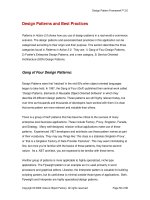Design Patterns and Best Practices
Bạn đang xem bản rút gọn của tài liệu. Xem và tải ngay bản đầy đủ của tài liệu tại đây (57.3 KB, 17 trang )
Design Pattern Framework™ 2.0
Design Patterns and Best Practices
Patterns in Action 2.0 shows how you use of design patterns in a real-world e-commerce
scenario. The design patterns and associated best practices in this application can be
categorized according to their origin and their purpose. This section describes the three
categories found in Patterns in Action 2.0. They are: 1) Gang of Four Design Patterns,
2) Fowler’s Enterprise Design Patterns, and a new category, 3) Service Oriented
Architecture (SOA) Design Patterns.
Gang of Four Design Patterns:
Design Patterns were first 'hatched' in the mid 90's when object-oriented languages
began to take hold. In 1997, the Gang of Four (GoF) published their seminal work called
“Design Patterns, Elements of Reusable Object-Oriented Software” in which they
describe 23 different design patterns. These patterns are still highly relevant today, but
over time as thousands and thousands of developers have worked with them it is clear
that some pattern are more relevant and valuable than others.
There is a group of GoF patterns that has become critical to the success of many
enterprise level business applications. These include Factory, Proxy, Singleton, Facade,
and Strategy. Many well-designed, mission-critical applications make use of these
patterns. Experienced .NET developers and architects use these pattern names as part
of their vocabulary. They may say things like: 'this class is a stateless Singleton Proxy',
or ‘that is a Singleton Factory of Data Provider Factories”. This may seem intimidating at
first, but once you're familiar with the basics of these patterns, they become second
nature. As a .NET architect, you are expected to be familiar with these terms.
Another group of patterns is more applicable to highly specialized, niche type
applications. The Flyweight pattern is an example as it is used primarily in word
processors and graphical editors. Likewise, the Interpreter pattern is valuable for building
scripting parsers, but its usefulness is minimal outside those types of applications. Both,
Flyweight and Interpreter are highly specialized design patterns.
Copyright © 2006, Data & Object Factory. All rights reserved. Page 50 of 66
Design Pattern Framework™ 2.0
Several patterns have proven so immensely useful that they ended up in programming
languages themselves. Examples are Iterator and Observer. The foreach (For Each in
VB) language construct is an implementation of the Iterator pattern. The .NET eventing
model with events and delegates is an implementation of the Observer design pattern.
These examples show just how pervasive design patterns have become in everyday
programming. Please note that this document does not further address or elaborate on
these 'language' patterns specifically.
The majority of the GoF patterns falls into a category that is important but at a more
granular and localized level (unlike the application level architecture patterns such as
Façade and Factory). They are used in more specialized and focused circumstances.
Examples include: State, Decorator, Builder, Prototype, and Template. The State
pattern, for example, is used when you have clearly defined state transitions such as a
credit card application process that goes through a sequence of steps. The Decorator is
used for extending the functionality of an existing class. The Template is used to provide
a way to defer implementation details to a derived class while leaving the general
algorithmic steps in tact. Several others exist. Again, they are frequently used, but at a
more detailed and focused level within the application.
Finally, there is a small group of patterns that is rarely used. These include the Visitor
and Memento design patterns.
A note about the Factory pattern: the GoF patterns contain two Factory patterns, namely
Abstract Factory and Factory Method. The Abstract Factory pattern is essentially a
generalization of the Factory Method as it creates families of related classes that interact
with each other in predictable ways. Over time the differences between the two have
become blurry as developers mostly talk about the Factory pattern, meaning a class that
manufactures objects that share a common interface or base class. These
manufactured objects may or may not interact with each other. In Patterns in Action 2.0
we have also adopted this usage and refer to it simply as the Factory pattern.
Microsoft introduced the Provider design pattern in .NET 2.0. Although it is not a GoF
pattern (it was not part of the original 23 patterns), it is included here because you’ll find
Copyright © 2006, Data & Object Factory. All rights reserved. Page 51 of 66
Design Pattern Framework™ 2.0
it used throughout .NET 2.0. Provider is essentially a blending of three GoF design
patterns. Functionally, it is closest to the Strategy design pattern, but it makes extensive
use of the Factory and Singleton patterns.
Patterns in Action 2.0 is a reasonable representation of how patterns are used in the real
world. It includes only the most valuable and most frequently used design patterns in
real-world application development. We could have crammed all 23 GoF patterns in the
application, but that would have skewed reality by not reflecting the real-world usage of
design patterns.
The table below summarizes the GoF patterns used in the application, their location, and
their usage. These patterns are referenced also in the code comments. Possibly the
best way to study these is to have the source code side-by-side with the 69 Design
Pattern Projects that are part of the Design Pattern Framework.
GoF
Design
Pattern
Project Class Usage
Proxy BusinessObjects ProxyList
Used as base class for proxy
objects representing a list of
items.
Façade Façade CustomerFacade
ProductFacade
Used as the façade (or service
interface) into the business layer.
All communication to the business
layer goes through the façade.
Proxy Façade ProxyForOrderDetails
ProxyForOders
Used as proxies for list of orders
and list of order details. A way to
limit database access to what is
absolutely necessary.
Factory DataObjects DaoFactories
DaoFactory
Used in the manufacture of other
classes. Each database (MS
Access, Sql Server, Oracle) has
its own Factory which creates
database specific data access
classes.
Proxy DataObjects DataAccess
Used as easy data access
interface for the business layer.
Singleton DataObjects Db Used for low level data access.
Only one stateless Db object is
required for the entire application.
Strategy Cart IShipping
ShippingStrategyFedex
ShippingStrategyUPS
ShippingStrategyUSPS
Used to selectively choose a
different shipping method that
computes shipping costs.
Copyright © 2006, Data & Object Factory. All rights reserved. Page 52 of 66
Design Pattern Framework™ 2.0
Composite Controls MenuComposite
MenuCompositeItem
Used to represent the hierarchical
tree structure of the menu.
Observer Log ObserverLogToDatabase
ObserverLogToEmail
ObserverLogToEventLog
ObserverLogToFile
Used to ‘listen to’ error events and
log messages to a logging output
device, such as email, event log,
etc.
Decorator Transactions TransactionDecorator Used to ‘embrace and extend’ the
functionality of the built-in
TransactionScope class.
Provider
(Microsoft
Pattern)
ViewState ViewStateProviderCache
ViewStateProviderGlobal
ViewStateProviderSession
Used to build several providers
that can hold ViewState on the
server and therefore limit the size
of the pages being sent to the
browser.
Singleton ViewState GlobalViewStateSingleton Used to hold all available view
state providers.
Iterator All Projects foreach language
construct (For Each in VB)
Iterator is built in the .NET
programming languages.
Observer All Projects .NET event model Observer is built in the .NET
programming languages.
Copyright © 2006, Data & Object Factory. All rights reserved. Page 53 of 66
Design Pattern Framework™ 2.0
Enterprise Design Patterns:
In 2003, Martin Fowler’s book was published titled: "Patterns of Enterprise Application
Architecture". Supposedly, it was written for both Java and .NET developers, but there is
a slant towards the Java side of things. This book provides an extensive catalog of
patterns and best practices used in developing data driven enterprise-level applications.
The word ‘pattern’ is used more loosely in this book. It is best to think about these
patterns as best practice solutions to commonly occurring enterprise application
problems. It proposes a layered architecture in which presentation, domain model, and
data source make up the three principal layers. This layering exactly matches the 3-tier
model employed in Patterns in Action 2.0.
Initially, many of the Enterprise patterns in this book may seem trivial and irrelevant to
.NET developers. The reason is that the .NET Framework has many Enterprise patterns
built-in. This shields .NET developers from having to write any code that implements the
design pattern. In fact, developers do not even have to know that there is a common
pattern or best practice underlying the feature under consideration. There are many
examples of this, such as, Client Session State (this is the Session object), Model View
Controller (which is not really applicable to ASP.NET), Record Set (which is DataTable
object), and the Page Controller (pages that derive from the Page class -- i.e. the code
behind)
Even so, Fowler’s book is useful in that it provides a clear catalog of patterns for those
architecting large and complex enterprise level applications. It also offers a glimpse into
the issues that Java developers have to be concerned about which is useful for teams
that are supporting multiple platforms. In a sense, Microsoft has made many decisions
by providing best practice solutions to common problems. For example, most developers
do not question the DataTable object -- they simply use it. As a .NET developer, you
could write your own in-memory database table, but most would never consider doing
such a ‘silly’ thing.
Copyright © 2006, Data & Object Factory. All rights reserved. Page 54 of 66
Design Pattern Framework™ 2.0
The Java world was earlier in accepting and embracing the concept of Design Patterns
and they got a head start. However, with more and more developers moving to the pure
OO world of .NET the .NET community is catching up quickly.
Enterprise
Design
Patterns
Project Class Usage
Domain
Model
BusinessObjects Catalog, Product,
Customer, Order,
Order Detail
Business Objects is essentially
a different name for Domain
model.
Identity Field BusinessObjects Category, Product,
Customer, Order
The identity value is the only
link between the database
record and the business
object.
LazyLoad BusinessObjects ProxyList The basic elements for
applying the LazyLoad pattern
are laid out in this base class.
LazyLoad Façade ProxyForOrderDetails
ProxyForOrders
Implementation of the
LazyLoad pattern outlined in
the ProxyList base class;
Remote
Façade
Façade CustomerFacade
ProductFacade
The API is course grained
because it deals with business
objects rather than attribute
values.
Service Layer Façade CustomerFacade
ProductFacade
A service layer that sits on top
of the Domain model (business
objects)
LazyLoad Façade CustomerFacade
LazyLoad proxy objects are
assigned to Customer and
Order business objects
Transaction
Script
Façade CustomerFacade
ProductFacade
The Façade API is course
grained and each method
handles indivual presentation
layer requests.
Table Module Cart ShoppingCart Shopping Cart logic is handled
by one class holding a
DataTable. Cart is non-
persistent, but by making it
persistent it would be a single
table..
Data Table
Gateway
Cart ShoppingCart Again, if this were a persistent
shopping cart one instance
would handle all rows in the
database table.
Transform
View
Controls MenuComposite Menu items are processed and
then transformed into HTML
LazyLoad ViewState ViewStateProviderService ViewState Providers are
loaded only when really
necessary
Page
Controller
Web Site PageBase Each page has its own
controller code. This is how in
ASP.NET pages are built.
Copyright © 2006, Data & Object Factory. All rights reserved. Page 55 of 66









